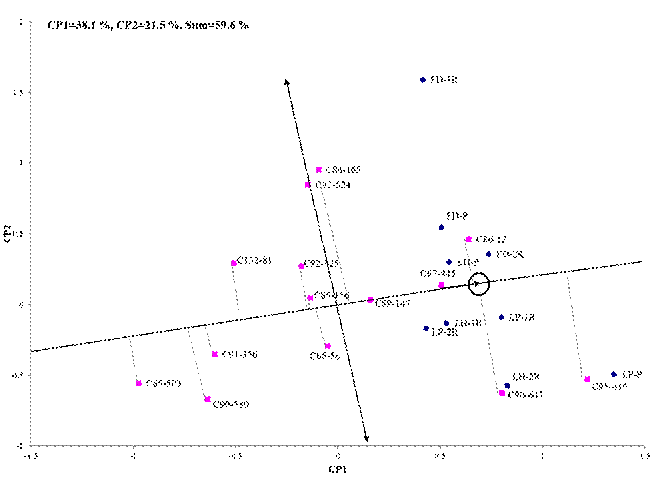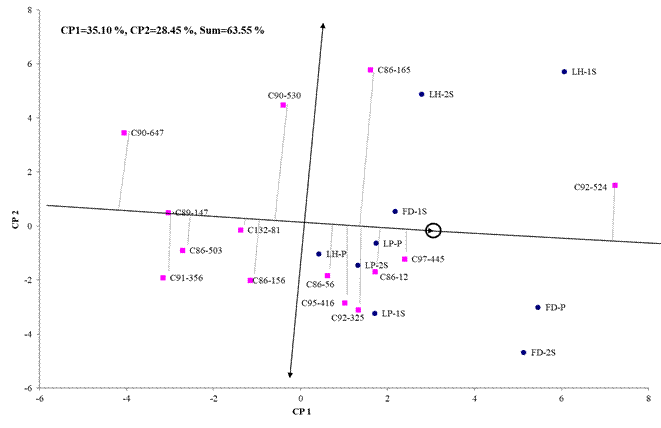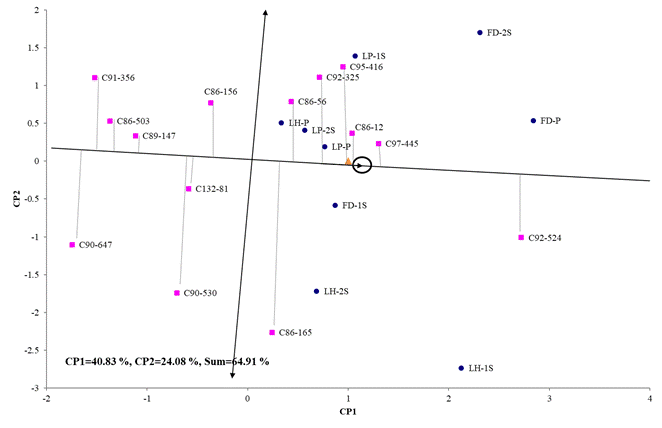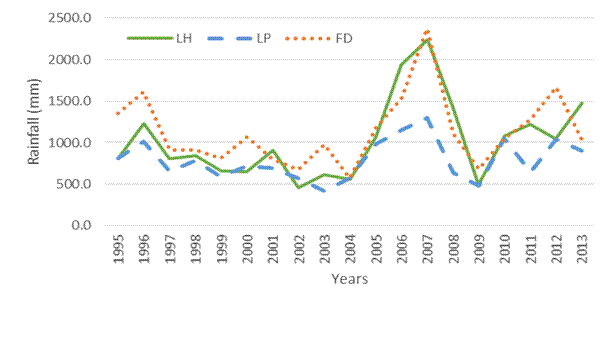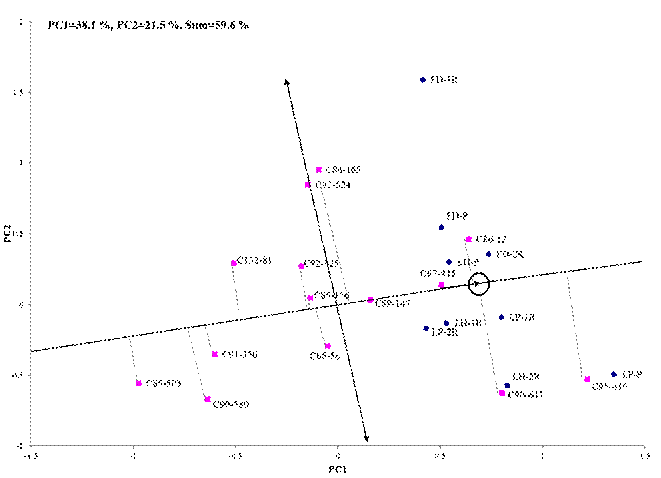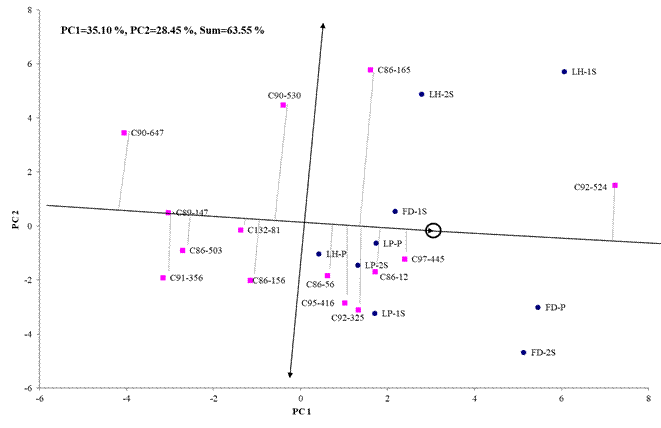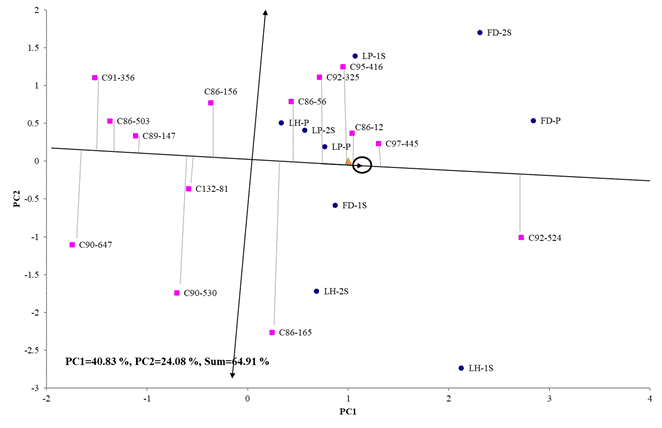Translate PaperArtículo originalEstabilidad fenotípica de nuevos cultivares de Saccharum spp. híbrido en ensayos multiambientales en Holguín
[0000-0002-1858-0862] Yulexi Mendoza-Batista [1] [*]
[0000-0002-5890-514X] Rubisel Cruz-Sarmiento [1]
[0000-0003-3910-2656] Reynaldo Rodríguez-Gross [2]
[0000-0002-1734-2651] Irene Expósito-Elizagaray [3]
[0000-0001-6608-4997] Yaquelin Puchades-Izaguirre [2]
[0000-0003-3216-4395] Arián Céspedes-Zayas [1]
[1] Estación Provincial de Investigaciones de la Caña de Azúcar (EPICA), Holguín, Cuba
[2] Instituto de Investigaciones de la Caña de Azúcar (INICA), carretera CUJAE km 1½, Rancho Boyeros, La Habana, Cuba, CP 19390
[3] Universidad de Granma, carretera Manzanillo, km 17, Bayamo, Granma, Cuba, CP 85 100
[*] Autor para correspondencia: yulexi.mendoza@inicahl.azcuba.cu; yuleximb@yahoo.com
RESUMENPara la
realización de este trabajo se establecieron tres experimentos de campo
en las Unidades Empresariales de Base “Loynaz Hechavarría”, “Fernando de
Dios” y “López-Peña”, pertenecientes a la Empresa Azucarera Holguín,
donde se emplearon 12 cultivares y dos testigos bajo condiciones de
secano, durante el período octubre 2010 a marzo 2014; se evaluaron las
variables de cosecha (porcentaje de pol en caña, toneladas de caña por
hectárea y toneladas de pol por hectárea), con el objetivo de
identificar los cultivares que presentan estabilidad fenotípica general
en los diferentes ambientes en estudio. Se aplicaron métodos de análisis
multivariados para evaluar genotipos, ambientes y la interacción
genotipo-ambiente. El uso del modelo multivariado de efectos principales
de los genotipos más los efectos de la interacción genotipo-ambiente
(GGE biplot), del modelo de Regresión de Sitios (SREG) permitió
identificar los cultivares de mejores rendimientos y con estabilidad
general en todos los ambientes, los cuales fueron C92-524, C97-445 y
C95-416. Estos cultivares presentaron, además, un comportamiento
fitosanitario satisfactorio en condiciones naturales. Se recomienda la
incorporación de los mismos a los proyectos de variedades de las
Unidades Empresariales de Base de la Empresa Azucarera Holguín, donde
fueron evaluados.
INTRODUCCIÓNEn
Cuba se han realizado numerosos estudios relacionados con la evaluación
de genotipos en diferentes ambientes de producción y sus implicaciones
en el mejoramiento de los rendimientos cañeros y azucareros; no
obstante, el estudio de este aspecto en la provincia Holguín no ha sido
abordado con amplitud en los últimos años, a pesar de los grandes
cambios producidos en la industria azucarera cubana y el clima. Los
resultados de estos estudios reiteran la importancia y significación de
la interacción genotipo-ambiente, lo que apunta a la necesaria
evaluación multiambiental de los cultivares durante el proceso de
selección, fundamentalmente en las etapas finales, así como posterior a
su liberación en áreas comerciales 1.
Sin
embargo, el reordenamiento de la agroindustria azucarera en Cuba y, con
ello, la reestructuración de la infraestructura para la
investigación-desarrollo en este sector, motivaron un reordenamiento de
las investigaciones y reducción de la red experimental y de los sitios
de pruebas de nuevos cultivares, lo que provocó poca correspondencia
entre los ambientes de selección genética y los ambientes de destino de
los cultivares 2.
El
insuficiente conocimiento de la respuesta agroazucarera de los nuevos
cultivares comerciales de caña de azúcar en localidades de la provincia
Holguín en condiciones de secano, limita la adecuada selección,
recomendación y manejo de estos en los ambientes de producción de la
provincia, por lo que con este estudio se persigue evaluar la respuesta
de los cultivares en estudio recomendados en los últimos años, bajo
condiciones de secano en diferentes localidades de la provincia Holguín e
identificar mediante el método de Regresión de Sitios los cultivares
que presentan estabilidad fenotípica general para las tres variables
evaluadas en las localidades en estudio.
MATERIALES Y MÉTODOSLas localidades y los tipos de suelos donde se plantaron los experimentos se presentan en la Tabla 1. La clasificación de los suelos se realizó según la Nueva Versión de la Clasificación Genética de los Suelos de Cuba 3. En octubre de 2010, se estableció un experimento de campo en cada localidad y se evaluaron hasta marzo de 2014.
En la Tabla 2 se muestran
los 14 cultivares de caña de azúcar empleados en el estudio, incluyendo
dos testigos, la mayoría de los cultivares fueron recomendados en los
últimos años para otras zonas geográficas del país.
Para el montaje de los experimentos se utilizó el diseño de bloques al azar con tres repeticiones, con parcelas de 48 m2.
Las evaluaciones se realizaron en las cepas de caña planta (P), primer
retoño (1R) y segundo retoño (2R) a los 16, 13 y 12 meses de edad,
respectivamente. Las variables de cosecha evaluadas fueron porcentaje de
pol en caña (PPC); toneladas de caña por hectárea (TCH) y toneladas de
pol por hectárea (TPH); se evaluó, además, el comportamiento
fitopatológico ante la roya parda (Puccinia melanocephala H. and P. Sydow) y el carbón (Sporisorium scitamineum
(Syd.) M. Piepenbr., M. Stoll & Oberw.) en condiciones naturales.
Todos los experimentos fueron conducidos y evaluados, según está
estipulado en las Normas y Procedimientos del Programa de
Fitomejoramiento de la Caña de Azúcar en Cuba 4.
Se
emplearon nueve ambientes, los mismos se refieren a la combinación de
las localidades y años (cepas), combinación comúnmente empleada por
diferentes autores 5,6
en estudios de este tipo en caña de azúcar. Los datos originales de las
variables de cosecha, se evaluaron respecto a su normalidad y
homogeneidad de varianza, mediante pruebas de Chí cuadrado y
Bartlett-Box F. No fue necesario transformar los datos. Para el
procesamiento estadístico de los datos se empleó el software Statistica
v.8.
Se realizó un análisis de varianza
factorial con modelo de efectos fijos para conocer si existía
interacción genotipo-ambiente y aplicar análisis de estabilidad
fenotípica a las variables de cosecha donde la interacción resultó
significativa. Para esto se tomaron como factores los genotipos,
localidades y cepas, de acuerdo con el modelo de Cochran y Cox (1965).
Se calculó la contribución de cada una de las fuentes de variación a la
varianza fenotípica total.
Para la estimación
de la estabilidad, se utilizó el modelo multivariado de efectos
principales de los genotipos, más efectos de la interacción
genotipo-ambiente (GGE, por sus siglas en ingles), del modelo de
Regresión de Sitios (SREG). Para presentar el comportamiento medio y
estabilidad de los genotipos en todos los ambientes se utilizó el biplot
que muestra el ambiente promedio, que se obtiene mediante la media de
las coordenadas de los ambientes (se representa mediante un pequeño
círculo). La ordenada del ambiente promedio es la recta que pasa por el
origen del biplot y es perpendicular al eje de las abscisas, esta línea
con dos flechas indica mayor variabilidad (pobre estabilidad) en
cualquier dirección 7.
Se
utilizaron las informaciones existentes de las precipitaciones
registradas por las redes pluviométricas del Instituto de Recursos
Hidráulicos, ubicadas en cada localidad, durante el periodo en que se
llevaron a cabo los estudios, así como las series históricas del período
1995-2013 de cada una de estas localidades.
RESULTADOS Y DISCUSIÓNLos resultados del análisis de varianza factorial (Tabla 3),
mostraron que tanto los factores simples, como sus interacciones
resultaron significativos (p≤0,05), para las tres variables de cosecha
(PPC, TCH, TPH), lo que significa que los genotipos mostraron diferentes
patrones de comportamiento en las distintas cepas y localidades en
estudio, confirmándose la existencia de interacción de los genotipos con
el ambiente e indica, coincidiendo con lo planteado por otro autor 8, que será más efectivo seleccionar los genotipos de respuesta específica a cada ambiente de producción.
Al respecto, varios autores plantearon que
cuando la interacción genotipo-ambiente está presente, el medio ambiente
es uno de los factores más influyentes que afecta la selección del
genotipo 9.
Además,
se apreció el predominio de los componentes ambientales (porcentaje
extraído de la suma de cuadrados de los factores ambientales como,
localidad, cepa y su interacción) sobre la suma de cuadrados total, 49,3
% para el porcentaje de pol en caña, 65,1 % para las TCH y 68,6 % para
las TPH, resultados similares fueron informados en estudios
multiambientales en la provincia Santiago de Cuba 8.
En
un estudio realizado en siete localidades de Venezuela, plantearon que
el rendimiento promedio en caña fue significativamente afectado por los
efectos ambientales y genotípicos, los cuales explicaron el 41,16 y
40,67 % de la suma de cuadrados total, respectivamente 10.
En
el contexto específico de las localidades en estudio, resulta muy
importante que determinados cultivares se comporten favorablemente, pues
estas zonas geográficas se caracterizan por presentar precipitaciones
insuficientes y generalmente mal distribuidas. Al analizar el
comportamiento histórico de las precipitaciones en el período 1995-2013 (Figura 1),
se puede observar que en la localidad “López-Peña” durante todo el
período, las precipitaciones anuales fueron inferiores a los 1500 mm,
cifra que señalan algunos autores 11,12,
como necesidad hídrica de la caña de azúcar. Comportamiento similar
alcanzaron las otras localidades en estudio, pues “Loynaz Hechavarría”
solo alcanzó precipitaciones anuales por encima de la cifra antes
señalada, en los años 2006 y 2007, al igual que “Fernando de Dios” que
además de estos dos años, alcanzó un ligero incremento de las lluvias en
1996 y 2012; no obstante, se observó que las precipitaciones no
satisfacen las necesidades hídricas del cultivo, coincidiendo con los
resultados alcanzados por varios autores 13,
quienes plantearon que los mayores valores de precipitaciones se
alcanzaron en la región más al norte de la provincia Holguín y
demostraron mediante climogramas que estas localidades en estudio
presentaron déficit de humedad en el suelo durante todo el año, debido a
los altos valores de evaporación y al pobre acumulado de las lluvias.
Comportamiento anual de las precipitaciones durante 19 años en las localidades Loynaz Hechavarría, López-Peña y Fernando de Dios
Con respecto al comportamiento fitosanitario
de los cultivares empleados en el estudio podemos decir que no fueron
afectados por el Carbón (Sporisorium scitamineum (Syd.) M. Piepenbr., M. Stoll & Oberw.) y la Roya parda (Puccinia melanocephala
H. and P. Sydow) en condiciones naturales, lo que corrobora los
resultados alcanzados en la prueba estatal de Carbón por inoculación
artificial y la prueba estatal de Roya parda con foco de infección,
donde estos cultivares presentaron resistencia múltiple a ambas
enfermedades.
La existencia de diferencias
significativas en la interacción localidad-cultivar-cepa justifica la
aplicación del modelo de SREG. La variabilidad de la respuesta azucarera
de los cultivares en los ambientes en estudio se confirmó mediante el
análisis del comportamiento promedio y la estabilidad (Figura 2),
el componente principal 1 (CP1) representa el promedio de PPC de los
cultivares y el CP2 está relacionado con la interacción
genotipo-ambiente, estos componentes, en su conjunto, explican el 59,6 %
de la variabilidad total contenida en los efectos de los genotipos más
la interacción genotipo-ambiente. Este porcentaje se considera adecuado
para representar las relaciones entre ambientes, genotipos y entre estos
por medio de los diferentes representaciones bidimensionales (biplots)
que se pueden obtener con el modelo de Regresión de Sitios 14.
Las
proyecciones de los marcadores genotipos sobre el eje que pasa por el
origen del biplot y el ambiente promedio, obtenido de la media de las
coordenadas de los ambientes, aproximan los valores medios de los
genotipos, por lo que los cultivares aparecen ordenados a lo largo del
eje con la flecha apuntando al mayor valor. Por lo que al analizar la Figura 2
se observa que el cultivar C95-416 alcanzó el contenido azucarero medio
más alto, seguido por C90-647, C86-12 (testigo), C97-445 y C89-147; no
obstante, entre ellos los más estables fueron los dos últimos. En un
estudio realizado en la región sur oriental de Cuba, se señaló a los
genotipos C90-647 y C86-12 como los más estables y de alto contenido
azucarero 5.
Los
cultivares más inestables fueron C86-165, C90-647 y C95-416, pues
alcanzaron altos valores de porcentaje de pol en caña en algunos
ambientes pero fueron los más bajos en otros.
El análisis GGE Biplot se ha empleado con éxito en estudios de estabilidad fenotípica en diversos cultivos como soya (Glycine max L.) y algodón (Gossypium hirsutum L.). Recientemente, en un estudio desarrollado por varios autores 15,
en diferentes localidades de las colinas del Himalaya, con el uso del
GGE Biplot identificaron la variedad de soya “VLS 89” estable y con alto
rendimiento. Asimismo, en un estudio realizado en ocho ambientes de
Brasil donde se emplearon 16 genotipos de algodón con el objetivo de
determinar adaptabilidad y estabilidad mediante el método GGE biplot, el
autor se refiere que dos genotipos se destacaron como los más estables,
combinando amplia adaptación y productividad 16. Otro autor utilizó la metodología GGE biplot para evaluar la adaptabilidad y estabilidad de genotipos de melón (Cucumis melo) en cuatro condiciones de salinidad (ambientes) y pudo identificar siete accesiones tolerantes a la salinidad 17.
Representación biplot del modelo de Regresión de Sitios del comportamiento medio y estabilidad de los genotipos para el PPC
CP1
y CP2 (Componentes principales 1 y 2), LH (Loynaz Hechavarría). LP
(López - Peña), FD (Fernando de Dios), P (Cepa planta), 1R (Primer
retoño), 2R (Segundo retoño)
Con respecto al rendimiento agrícola (TCH)
el análisis del biplot logró explicar el 63,55 % de la variabilidad
total contenida en los efectos de los genotipos más la interacción
genotipo-ambiente, en los dos primeros componentes del modelo de
regresión de sitios (Figura 3). En cuanto al
comportamiento medio y la estabilidad de los genotipos en todos los
ambientes para el rendimiento agrícola, se destaca el genotipo C92-524
con rendimiento superior a la media de todos los ambientes, también
resultaron estables (genotipos más cercanos al eje de las abscisas) y
con rendimientos cercanos a la media de todos los ambientes, los
genotipos C97-445, C86-12 y C86-56; los genotipos C95-416 y C92-325
también alcanzaron rendimientos por encima de la media, pero fueron
menos estables que los cultivares mencionados anteriormente. En un
estudio realizado en diferentes ambientes de la provincia Matanzas, se
informó al cultivar C86-56 con buena adaptación general en todos los
ambientes para las variables de rendimiento agrícola y azucarero 6.
Representación bidimensional del modelo de Regresión de Sitios del comportamiento medio y estabilidad de los genotipos para TCH
CP1
y CP2 (Componentes principales 1 y 2), LH (Loynaz Hechavarría). LP
(López - Peña), FD (Fernando de Dios), P (Cepa planta), 1R (Primer
retoño), 2R (Segundo retoño)
En la figura anterior, se observa que el
genotipo C86-165 alcanzó rendimiento cercano a la media, pero fue
inestable, con buen comportamiento en las cepas de retoño de la
localidad “Loynaz Hechavarría”. Por otro lado, los cultivares de mayor
estabilidad fueron C89-147 y C132-81, pero con rendimientos agrícolas
inferiores a la media de los ambientes en estudio, coincidiendo con los
autores que plantean que los genotipos estables no son necesariamente
los más productivos 18.
Un colectivo de autores revelan que el uso del GGE biplot del modelo SREG les permitió identificar los genotipos de Michelia chapensis
más estables y de alto rendimiento y confirmaron el sitio más
representativo y discriminativo entre los tres ambientes estudiados al
sur de China 19.
Varios
autores utilizaron el modelo SREG para evaluar la estabilidad de once
genotipos de maíz cultivados en seis localidades de México y concluyen
que el modelo SREG es una buena herramienta para evaluar la estabilidad
de los rasgos de rendimiento y calidad de los granos para el proceso de
nixtamalización de genotipos de maíz y permitió identificar el mejor
genotipo para recomendación para varias localidades 20.
De
igual manera usaron el análisis GGE biplot para evaluar la estabilidad
en el rendimiento del trigo en Irán e identificar los mejores genotipos
en cada ambiente 21.
En
el caso de la variable TPH, el efecto de los genotipos más la
interacción genotipo-ambiente alcanzó el orden de 64,91 % de la
variabilidad total, observada en sus dos primeros componentes (Figura 4).
Los cultivares C97-445, C92-524 y el testigo C86-12 fueron los más
estables entre los genotipos que alcanzaron altos valores de TPH,
variable que representa el rendimiento de azúcar por unidad de
superficie, los genotipos C95-416 y C92-325 también alcanzaron
rendimientos azucareros cercanos a la media de todas las localidades,
pero sus resultados fueron más inestables que los mencionados
anteriormente. Los genotipos más inestables fueron C86-165 y C90-530. En
el biplot también se observa que C91-356, C90-647 y el testigo C86-503
fueron los cultivares que presentaron el rendimiento azucarero medio más
bajo.
Representación bidimensional del modelo de Regresión de Sitios del comportamiento medio y estabilidad de los genotipos para TPH
CP1
y CP2 (Componentes principales 1 y 2), LH (Loynaz Hechavarría). LP
(López - Peña), FD (Fernando de Dios), P (Cepa planta), 1R (Primer
retoño), 2R (Segundo retoño)
Resultados similares han obtenido otros
autores mediante el uso del biplot para identificar cultivares estables
en diferentes ambientes; en un estudio realizado en diferentes ambientes
en Kenya, un colectivo de autores determinaron los genotipos de sorgo
dulce (Sorghum Moench) más estables y el genotipo que mostró adaptabilidad general a todos los ambientes en estudio 22. También mediante el uso del GGE biplot varios autores identificaron los mejores genotipos de canola (Brassica napus) en cuanto a rendimiento y contenido de aceite 23.
Asimismo, otros autores emplearon el análisis GGE Biplot para estudiar
el comportamiento de diferentes genotipos de forraje en Turkía 24.
CONCLUSIONES
El
uso del modelo SREG mediante el GGE biplot, permitió identificar y
recomendar los cultivares con comportamiento estable en todos los
ambientes en estudio
Se comprobó la
existencia de la interacción genotipo-ambiente en los sitios estudiados y
se destacaron los cultivares C92-524, C97-445 y C95-416, pues entre los
cultivares que mostraron mejores rendimientos, estos fueron los que
presentaron estabilidad fenotípica a todos los ambientes.
RECOMENDACIONESIncorporar
al proyecto de variedades de la Empresa Azucarera Holguín los
cultivares C92-524, C97-445 y C95-416, sin restricciones, por su
estabilidad agroindustrial en todos los ambientes estudiados.
INTRODUCTIONIn
Cuba, numerous studies have been carried out related to genotype
evaluation in different production environments and their implications
in improving sugarcane and sugar yields. However, the study of this
aspect in Holguín province has not been extensively addressed in recent
years, despite the great changes produced in the Cuban sugar industry
and the climate. The results of these studies reiterate the importance
and significance of the genotype-environment interaction, which points
to the necessary multi-environmental evaluation of cultivars during the
selection process, mainly in the final stages, as well as after their
release in commercial areas 1.
However,
the sugar agribusiness reorganization in Cuba and with it the
restructuring of the infrastructure for research-development in this
sector, led to a reordering of research and experimental network
reduction and testing sites for new cultivars which caused little
correspondence between the genetic selection environments and the target
environments of cultivars 2.
Insufficient
knowledge of agro-sugar response of new commercial sugarcane cultivars
in towns of Holguín province under rainfed conditions, limits the
adequate selection, recommendation and management of these in production
environments of this province, so with this study aims to evaluate the
response of the cultivars under study recommended in recent years, under
rainfed conditions in different locations in Holguín province, and to
identify cultivars that present general phenotypic stability for the
three variables using the Site Regression method evaluated in the study
locations.
MATERIALS AND METHODSThe localities and soil types where the experiments were planted are presented in Table 1. The classification of soils was carried out according to the New Version of the Genetic Classification of Cuban Soils 3. In October 2010, a field experiment was established in each location and they were evaluated until March 2014.
Table 2 shows the 14 sugarcane cultivars used in
the study, including two controls, most of the cultivars were
recommended in recent years for other geographical areas of the country.
The randomized block design with three replications, with plots of 48 m2,
was used to set up the experiments. The evaluations were carried out in
the plant (P), first shoot (1S) and second shoot (2S) strains at 16, 13
and 12 months of age, respectively. The harvest variables evaluated
were the percentage of pol in sugarcane (PPS), tons of sugarcane per
hectare (TSH) and tons of pol per hectare (TPH), the phytopathological
behavior was also evaluated against brown rust (Puccinia melanocephala H. and P. Sydow) and charcoal (Sporisorium scitamineum
(Syd.) M. Piepenbr., M. Stoll & Oberw.), under natural conditions.
All experiments were conducted and evaluated, as stipulated in Norms and
Procedures of Cuban Sugarcane Breeding Program 4.
Nine
environments were used, they refer to the combination of locations and
years (strains), a combination commonly used by different authors 5-6
in studies of this type in sugar cane. The original data of the harvest
variables were evaluated regarding their normality and variance
homogeneity, using Chi-square and Bartlett-Box F tests. It was not
necessary to transform the data. For data statistical processing, the
Statistica v.8 software was used.
A factorial
variance analysis was performed with a fixed effects model to know if
there was a genotype-environment interaction and apply phenotypic
stability analysis to the harvest variables where the interaction was
significant. For this, genotypes, localities and strains were taken as
factors, according to the model of Cochran and Cox (1965). The
contribution of each of variation sources to the total phenotypic
variance was calculated.
To estimate stability,
the multivariate model of main effects of genotypes, plus effects of
genotype-environment interaction (GEI), of the Site Regression Model
(SREG) was used. To present the average behavior and genotype stability
in all environments, the biplot was used that shows the average
environment, which is obtained by means of coordinate environment mean
(represented by a small circle). The ordinate of the average environment
is the line that passes through biplot origin and it is perpendicular
to the abscissa axis, this line with two arrows indicates greater
variability (poor stability) in any direction 7.
The
existing information on the rainfall recorded by the pluviometric
networks of the Institute of Hydraulic Resources, located in each
locality, during the period in which the studies were carried out, as
well as the historical series of the period 1995-2013 of each one of
these localities.
RESULTS AND DISCUSSIONThe results of the factorial variance analysis (Table 3),
showed that both the simple factors and their interactions were
significant (p≤0.05) for the three harvest variables (PPS, TSH, TPH),
which means that genotypes showed different behavior patterns in
different strains and localities under study, confirming the genotype
interaction existence with the environment and indicates, coinciding
with what was proposed by another author 8, that it will be more effective to select the response genotypes specific to each production environment.
In
this regard, several authors stated that when the genotype -
environment interaction is present, the environment is one of the most
influential factors affecting genotype selection 9.
In
addition, the predominance of environmental components (percentage
extracted from the squares sum of environmental factors such as,
locality, strain and their interaction) over the total squares sum, 49.3
% for the percentage of pol in sugar cane, 65 was appreciated. 1 % for
TSH and 68.6 % for TPH, similar results reported by other author in
multi-environmental studies in Santiago de Cuba province 8.
In
a study carried out in seven localities in Venezuela, they stated that
the average sugarcane yield was significantly affected by environmental
and genotypic effects, which explained 41.16 and 40.67 % of the total
sum of squares, respectively 10.
In the specific context of the localities
under study, it is very important that certain cultivars behave
favorably, since these geographical areas are characterized by
insufficient and generally poorly distributed rainfall. When analyzing
the historical rainfall behavior in the period 1995-2013 (Figure 1),
it can be seen that in "López-Peña" locality throughout the period,
annual rainfall was less than 1500 mm, a figure that some indicate
authors 11,12,
as the water requirement of sugar cane. Similar behavior reached the
other locations under study, since "Loynaz Hechavarría" locality only
achieved annual rainfall above the figure indicated above, in 2006 and
2007, as did "Fernando de Dios" locality, which in addition to these two
years, reached a slight increase in rainfall in 1996 and 2012, however,
it was observed that rainfall does not satisfy the water needs of the
crop, coinciding with the results achieved by several authors 13
who stated that the highest rainfall values were reached in the region
further north of Holguín province, and they demonstrated through
climograms that these study locations presented a deficit of moisture in
the soil throughout the year, due to high evaporation values and poor
accumulated rainfall.
Annual behavior of rainfall for 19 years in the Loynaz Hechavarría, López - Peña and Fernando de Dios localities
Regarding the phytosanitary behavior of cultivars used in the study, it can say that they were not affected by Carbon (Sporisorium scitamineum (Syd.) M. Piepenbr., M. Stoll & Oberw) and Brown rust (Puccinia melanocephala
H. and P. Sydow) under natural conditions, which corroborates the
results achieved in the state test Carbon for by artificial inoculation
and the state test for brown rust with an infection focus, where these
cultivars presented multiple resistance to both diseases.
The
existence of significant differences in the locality-cultivar-strain
interaction justifies SREG model application. The sugar response
variability of cultivars in the study environments was confirmed by
analyzing the average behavior and stability (Figure 2),
the pricipal component 1 (CP1) represents the average PPS of cultivars
and the CP2 is related with the genotype-environment interaction, these
components as a whole explain 59.6 % of the total variability contained
in genotype effects plus the genotype-environment interaction. This
percentage is considered adequate to represent the relationships between
environments, genotypes and between them through the different
two-dimensional representations (biplots) that can be obtained with the
Site Regression model 14.
The
projections of the genotype markers on the axis that passes through
biplot origin and the average environment, obtained from coordinate
environment mean, approximate the mean values of the genotypes, so that
cultivars appear ordered along axis with the arrow pointing to the
highest value. Therefore, when analyzing Figure 2, it
is observed that cultivar C95-416 reached the highest average sugar
content, followed by C90-647, C86-12 (control), C97-445 and C89-147,
however, among them the most stable were the last two. In a study
carried out in the southeastern region of Cuba indicated the genotypes
C90-647 and C86-12 as the most stable and with a high sugar content 5.
The
most unstable cultivars were C86-165, C90-647 and C95-416, since they
reached high values of percentage of pol in sugarcane in some
environments but were the lowest in others.
The GEI Biplot analysis has been used successfully in phenotypic stability studies in various crops such as soybeans (Glycine max L.) and cotton (Gossypium hirsutum L.). Recently, in a study developed by several authors in different locations in the Himalayan hills 15,
with the use of the GEI Biplot, they identified the stable and
high-yielding variety of soybean “VLS 89”. Likewise, in a study carried
out in eight environments in Brazil where 16 cotton genotypes were used
with the aim of determining adaptability and stability using the GEI
biplot method, an author refers that two genotypes stood out as the most
stable, combining broad adaptation and productivity 16. Another author used the GEI biplot methodology to evaluate the adaptability and stability of melon (Cucumis melo) genotypes in four salinity conditions (environments) 17) and it was able to identify seven salinity-tolerant accessions.
Biplot representation of the Site Regression model of the mean behavior and stability of genotypes for PPS
PC1
and PC2 (Principal components 1 and 2), LH (Loynaz Hechavarría). LP
(López - Peña), FD (Fernando de Dios), P (Plant strain), 1R (First
shoot), 2R (Second shoot)
With respect to agricultural yield (TCS),
the biplot analysis managed to explain 63.55 % of the total variability
contained in the effects of genotypes plus the genotype-environment
interaction, in the first two components of the site regression model (Figure 3).
Regarding the average behavior and stability of the genotypes in all
environments for agricultural performance, the C92-524 genotype stands
out with a yield higher than the average of all environments, they were
also stable (genotypes closer to the abscissa axis) and with yields
close to the average of all environments, genotypes C97-445, C86-12 and
C86-56; genotypes C95-416 and C92-325 also achieved above-average
yields, but were less stable than the cultivars mentioned above. In a
study carried out in different environments of the Matanzas province,
some authors reported cultivating C86-56 with good general adaptation in
all environments for the variables of agricultural and sugar yield 6.
Two-dimensional representation of the Site Regression model of the average behavior and stability of the genotypes for TSH
PC1
and PC2 (Principal components 1 and 2), LH (Loynaz Hechavarría). LP
(López - Peña), FD (Fernando de Dios), P (Plant strain), 1S (First
shoot), 2S (Second shoot)
In the previous figure, it is observed that
the C86-165 genotype reached yield close to the average, but was
unstable, with good behavior in the sucker strains of the “Loynaz
Hechavarría” locality. On the other hand, the cultivars with the highest
stability were C89-147 and C132-81, but with lower agricultural yields
than the average of the study environments, coinciding with another
author who argue that stable genotypes are not necessarily the most
productive 18.
A
group of authors revealed that the GEI biplot use of the SREG model
allowed them to identify the most stable and high-yield genotypes of Michelia chapensis, and confirmed the most representative and discriminative site among the three environments studied in southern China 19.
Several authors used the SREG model to evaluate the stability of eleven maize genotypes grown in six locations in Mexico 20)
and concluded that the SREG model is a good tool to evaluate the
stability of the yield and quality traits of the grains for
nixtamalization process of corn genotypes and allowed to identify the
best genotype for recommendation for several localities.
Likewise,
they used the GEI biplot analysis to evaluate the wheat yield stability
in Iran and identify the best genotypes in each environment 21.
In
the case of TPH variable, the genotype effect plus the
genotype-environment interaction reached the order of 64.91 % of the
total variability, observed in its first two components (Figure 4).
The cultivars C97-445, C92-524 and the control C86-12 were the most
stable among the genotypes that reached high values of TPH, a variable
that represents the sugar yield per unit area, the genotypes C95-416 and
C92-325 They also reached sugar yields close to the average of all
localities, but their results were more unstable than those mentioned
above. The most unstable genotypes were C86-165 and C90-530. In the
biplot it is also observed that C91-356, C90-647 and the control C86-503
were the cultivars that presented the lowest average sugar yield.
Two-dimensional representation of the Site Regression model of the average behavior and stability of genotypes for TPH
CP1
and CP2 (Principal components 1 and 2), LH (Loynaz Hechavarría). LP
(López-Peña), FD (Fernando de Dios), P (Plant strain), 1R (First shoot),
2R (Second shoot)
Similar results have been obtained by other
authors by using the biplot to identify stable cultivars in different
environments; in a study carried out in different environments in Kenya,
a group of authors determined the most stable sweet sorghum (Sorghum Moench) genotypes and the genotype that showed general adaptability to all study environments 22. Also by using the GEI biplot, several authors identified the best canola (Brassica napus) genotypes in terms of yield and oil content 23. Likewise, the authors used the GEI Biplot analysis to study the behavior of different forage genotypes in Turkey 24.
CONCLUSIONS
The
use os a model SREG using the GEI biplot let to identify and recommend
cultivars with stable behavior in all environment under study.
The
existence of the genotype-environment interaction was verified in the
studied sites and the cultivar C92-524, C97-445 y C95-416 were
highlighted, being these the ones that presented phenotypic stability to
all environments showing better yields.
RECOMMENDATIONSIt
is recommended the incorporation to the Project of varieties from
Holguín Sugar Company, C92-524, C97-445 and C95-416 cultivars without
restrictions for their agro-industrial stability in the environment
under study.
